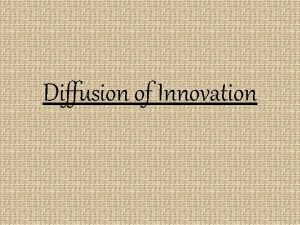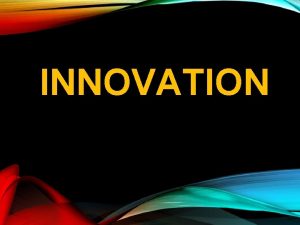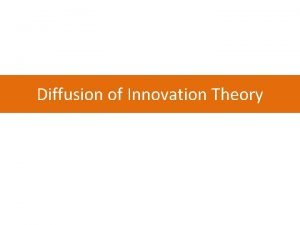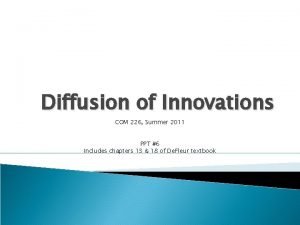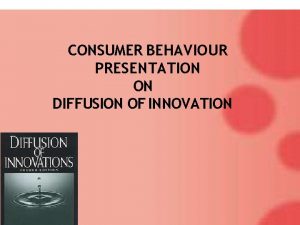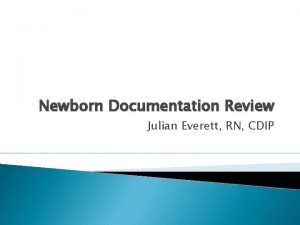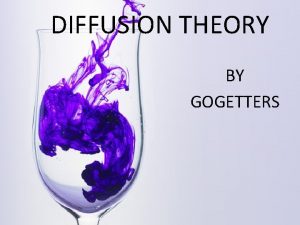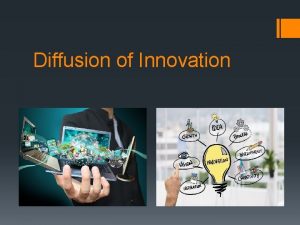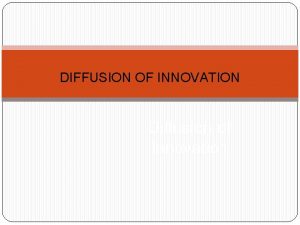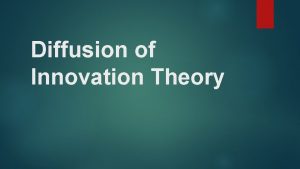Diffusion of Innovation Everett M Rogers 1995 4









- Slides: 9

Diffusion of Innovation Everett M. Rogers, 1995 (4 th edition) l Diffusion is the process by which (1) an innovation (2) is communicated through certain channels (3) over time (4) among the members of a social systems. l The Innovation: an idea, practices, or objects that is perceived as new by an individual or other unit of adoption Communication Channels: the means by which messages get from one individual to another Time: innovation-decision process; relative time with which an innovation is adopted by an individual or group; innovation’s rate of adoption Social System: a set of interrelated units that are engaged in joint problem solving to accomplish a common goal l

Process of Innovation Diffusion is the process by which an innovation is communicated through certain channels over time among the members of a social system. (Rogers)

5 Stages in the Innovation–Decision Process Prior Condition 1. Previous practice 2. Felt needs 3. Innovativeness 4. Organization Norms 1. Knowledge 2. Persuasion Communication Channels 3. Decision Perceived Characteristics Of the innovation 1. Relative advantage 2. Compatibility 3. Complexity 4. Trialability 5. Observability 4. Implementation 1. Adoption 2. Rejection 5. Confirm. Ation Continued Adoption Later Adoption Discontinuance Continued Rejection

Characteristics of Innovation l l l Relative Advantage: perceived benefits Compatibility: Perceived consistency with the existing values, past experiences, and needs Complexity: perceived difficulty in understanding or using the innovation Trialability: ability to experiment on a limited basis, pilot Observability: visible results

Adopter Categorization on the Basis of Innovativeness Deliberate Respect Venturesome Skeptical Traditional

Adopter Categories l Innovators: Venturesome l l Early Adopters: Respect l l 1/3 of the group, takes longer to adopt new ideas Late Majority: Skeptical l l Localites, opinion leaders, role models for potential adopters Early Majority: Deliberate l l Obsession with new ideas, cosmopolite social relationship 1/3 of the group, economical necessity, peer pressure Laggards: Traditional l The last to adopt an innovation; no opinion leadership, past is the reference point, longer decision process

Change Agents and Opinion Leaders l Roles of Change Agents l l l l To develop a need for change To establish an information –exchange relationship To diagnose problems To translate an intent to action To stabilize adoption and prevent discontinuance To achieve a terminal relationship Relationship with Opinion Leaders l l l Informally influence other’s attitudes about innovation; they have followers Leverage OL resources Demonstration

Factors Determining the Rate of Adoption of Innovations Perceived Characteristics of the innovation 1. Relative advantage (+) 2. Compatibility (+) 3. Complexity (-) 4. Trialability (+) 5. Observability (+) Type of Innovation-Decision 1. Optional 2. Collective 3. Authority Communication Channels mass media or interpersonal Nature of the Social Systems Norms, network interconnectedness Extent of Change Agent’s Promotion (+) Rate of Adoption Of Innovations

Innovation in Organizations Leader Characteristics • Attitude toward change (+) Internal Characteristics of Org. Structure 1. Centralization (-) 2. Complexity (+) 3. Formalization (-) 4. Interconnectedness (+) 5. Organizational slack (+) 6. Size (+) External Characteristics of the Org • System Openness (+) Organizational Innovativeness
